Navigating a Harsh World in the Language of Plants
- Isabel Carmen Johnson

- Feb 20
- 4 min read
Throughout my entire life, little secrets have been whispering under my feet. There are millions of plants I’ve trodden through, treaded upon, and trampled flat. With each stomp were networks of genes going this way and that (no doubt responding to wounding stress brought on by the bottom of my shoe).

Evidence of their silent communication is everywhere. It was in the backyard of my childhood home where daffodils knew exactly when to pop up from the ground in spring like clockwork. It was there when I saw presumably dead ferns burst forth in lush greens on the tops of bowed live oak branches after a particularly rainy day in the south.
Most of these seemingly miraculous wonders are carefully orchestrated and seemingly unnoticeable dialogues between the happenings of the Earth and the genetics of a plant. When something happens in the world around the plant, the plant can respond with the words made up of the letters A, T, C, and G (Adenine, Thymine, Cytosine, and Guanine).
Simply put, the DNA is likened to the vocabulary of a language, the RNA are the commands and words being spoken, and the proteins embody the resulting actions. The interactions of the proteins and compounds made from proteins form very complex sentences allowing the plant to do things from growing a new leaf to sensing where the light is coming from. However, different plant species have different “lexicons” to work with. Some plants possess the right words to sweet-talk the environment around them to allow them to stay healthy and live to make the next generation during stressful conditions like really low temperatures or heavy metals in the soil. However, some plants don’t posses the same “vocabulary.” So, when the environment chants of high temperatures and hot sun with little water, some plants are able to sing back in harmony, while other plants can never find the tune.
Our lab studies these complex assortments of DNA, RNA and proteins and, much like translating ancient texts, we try to decipher how they tell a story of adaptation and resilience. We try to understand how these stories fit within a larger narrative. For example, what RNA does a plant use that makes it able to survive high levels of stress? What “sentences” do those RNA “words” form? What are the mechanisms that allowed it to gain the “words” needed to survive this stress?
Environmental stress can have catastrophic results on the world’s food supply. Crops we rely on, such as corn, rice, and soybean, struggle to produce sufficient yields under stress, exacerbating food insecurity and worsening our already critical food problem. This is because crops don’t know the melody, they don’t have the genetic vocabulary to adapt to these stressful conditions, which can be disastrous for the humans that rely on them.
But what if we could study plants that have already evolved the "language" to survive in extreme conditions—and then teach that language to crops? That’s exactly what the Dassanayake Lab aims to do. Our goal is to help crops produce more food in the face of environmental stress. But where do we begin? First, we need to understand the "language" of plants already adapted to these conditions and find ways to translate it to crops.
Of course, when I say language I mean a sort-of genetic language. We are not actually trying to decipher an ancient text, we are trying to understand how genes and gene networks (the way genes/RNA/protiens can interact with each other) can inform actions that can then help the plant survive in stressful conditions.
Here is a very simplified example from our lab: there is a plant named Schrenkiella parvula (we’ll just call the plant Parvula) who can survive in really high salt conditions. Why is this important? Well, just like humans can’t drink sea water, plants like corn (and most crops) can’t survive in very salty conditions, either. One of the reasons it can’t survive is because excess sodium (Na+), which is one of the elements in table salt or sodium chloride (NaCl), is actually toxic to the plant and can mess up plant metabolisms at high levels. However, Parvula can actually store this extra sodium in a specialized pocket in its cells called the vacuole, which can help protect the plant from some of sodium’s toxic effects.
This is only one of the ways that Parvula has been found to adapt to high salt stress, but there are many more, and even many more that have not been investigated yet! Finding other ways these plants can deal with high salt is crucial to developing crops that can withstand stress.
Though plants cannot talk to us, we can still learn from them in their own language, and the language of all of us. It is becoming increasingly more important to find solutions to climate change to feed the exponentially growing population, and I suggest the first thing we should do is listen.

Comments